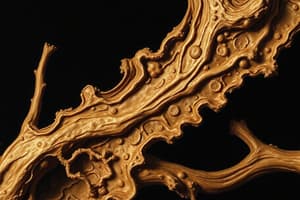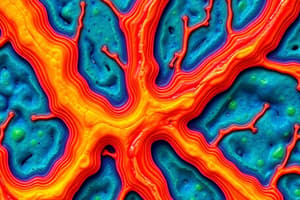Podcast
Questions and Answers
What type of cartilage forms the pubic symphysis?
What type of cartilage forms the pubic symphysis?
- Elastic cartilage
- Fibrocartilage (correct)
- Hyaline and elastic cartilage
- Hyaline cartilage
What is the function of macrophages?
What is the function of macrophages?
- To synthesize proteins
- To remove apoptotic cells and tissue debris (correct)
- To store energy
- To produce antibodies
What type of tissue is abundant at sites of inflammation?
What type of tissue is abundant at sites of inflammation?
- Loose connective tissue
- Adipose tissue
- Dense irregular connective tissue
- Macrophages (correct)
What type of collagen is present in bone tissue?
What type of collagen is present in bone tissue?
What type of cartilage forms the articular cartilage of joints?
What type of cartilage forms the articular cartilage of joints?
What type of tissue is composed of type I collagen bundles and fibroblasts?
What type of tissue is composed of type I collagen bundles and fibroblasts?
What type of fibers are present in the stroma of hemopoietic tissue?
What type of fibers are present in the stroma of hemopoietic tissue?
What type of cells produce antibodies?
What type of cells produce antibodies?
What is the term for the fluid connective tissue that circulates throughout the body?
What is the term for the fluid connective tissue that circulates throughout the body?
Which type of cell is responsible for producing antibodies during an immune response?
Which type of cell is responsible for producing antibodies during an immune response?
What is the main component of hematocrit?
What is the main component of hematocrit?
What is the function of albumin in the blood?
What is the function of albumin in the blood?
What is the approximate lifespan of circulating erythrocytes?
What is the approximate lifespan of circulating erythrocytes?
Which type of cell contains specific granules?
Which type of cell contains specific granules?
What is the term for a type of cell that releases enzyme histaminase to decrease the amount of histamine during allergic reactions?
What is the term for a type of cell that releases enzyme histaminase to decrease the amount of histamine during allergic reactions?
What is the reason for sickle cell anemia?
What is the reason for sickle cell anemia?
Which type of blood cell differentiates outside of the bone marrow?
Which type of blood cell differentiates outside of the bone marrow?
What is not considered a 'formed element' in blood?
What is not considered a 'formed element' in blood?
Which substance increases vascular wall permeability leading to edema?
Which substance increases vascular wall permeability leading to edema?
What is the substance consisting of apoptotic neutrophils, bacteria, semidigested material, and tissue fluid?
What is the substance consisting of apoptotic neutrophils, bacteria, semidigested material, and tissue fluid?
Which type of blood cell is the most abundant in a peripheral smear?
Which type of blood cell is the most abundant in a peripheral smear?
Which cells belong to granulocytes?
Which cells belong to granulocytes?
Which cell type has surface receptors for immunoglobulin E (IgE)?
Which cell type has surface receptors for immunoglobulin E (IgE)?
Which type of cell is formed by the fragmentation of megakaryocytes?
Which type of cell is formed by the fragmentation of megakaryocytes?
Flashcards are hidden until you start studying
Study Notes
Cartilage
- Pubic symphysis is formed by hyaline cartilage.
- Epiphyseal plate is formed by hyaline cartilage.
- Articular cartilage of joints is formed by hyaline cartilage.
Collagen
- Type II collagen is found in cartilage.
- Type III collagen is not found in cartilage.
- Type VI collagen is not found in cartilage.
- Type I collagen is found in bone tissue.
Connective Tissue
- Macrophages are cells derived from monocytes, specialized in protein fiber turnover and removal of apoptotic cells, tissue debris, or other particulate material.
- Loose connective tissue is located beneath the epithelial lining of many organs and fills the spaces between fibers of muscle and nerve.
- Dense irregular connective tissue is found in skin, fascia, and tendon sheaths.
- Reticular fibers are present in the stroma of hemopoietic tissue (bone marrow), the spleen, and lymph nodes.
Blood Cells
- Plasma cells are lymphocyte-derived, antibody-producing cells.
- Basophils are granulocytes with surface receptors for immunoglobulin E (IgE).
- Eosinophils are granulocytes with large, blue granules that often obscure the nucleus.
- Monocytes mature into macrophages.
- Neutrophils are the most abundant in a peripheral smear of blood.
Blood Components
- Pus is a substance consisting of apoptotic neutrophils, bacteria, semidigested material, and tissue fluid.
- Histamine increases vascular wall permeability, leading to edema.
- Platelet-activating factor increases vascular wall permeability, leading to edema.
- Hematocrit is the volume of packed RBCs in a sample of blood.
Blood Functions
- Albumin maintains osmotic pressure.
- Eosinophils release enzyme histaminase to decrease the amount of histamine during allergic reactions.
- The approximate lifespan of circulating erythrocytes is 4 months.
Other
- Chondronectin is a glycoprotein of cartilage tissue.
- Osteonectin is a glycoprotein of bone tissue.
- Fibronectin is a glycoprotein of loose connective tissue.
- Aggrecan is a glycoprotein of cartilage tissue.
- Lymphocytes are associated with antibody production.
- The function of hematocrit is to measure the volume of packed RBCs in a sample of blood.
Studying That Suits You
Use AI to generate personalized quizzes and flashcards to suit your learning preferences.




